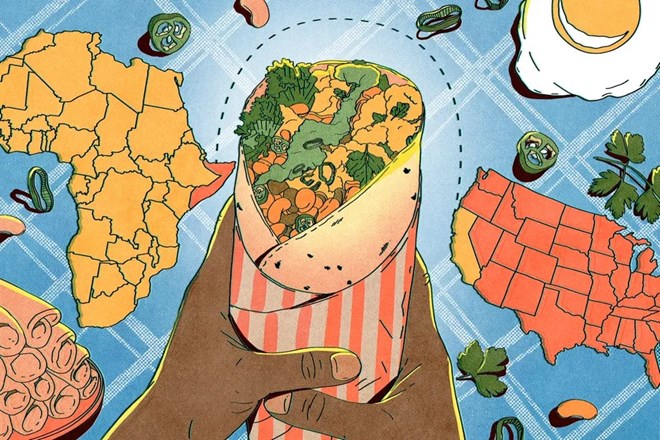
Monday April 17, 2023
By Ifrah F. Ahmed
How Somali food in the diaspora holds the history of forced migration

María Jesús Contreras/Eater
Early last year, I launched a pop-up in Los Angeles that gave birth to a new culinary idea that I had been toying with for over a decade. In a city that famously loves breakfast burritos, I began to sell a Somali-style wrap — spongy and sour anjero-wrapped breakfast burritos filled with soft scrambled eggs, fuul (fava bean stew), and spicy vibrant green basbaas (Somali hot sauce). Much to my surprise, I sold out week after week, despite the fact that for many of my LA customers, this was their first introduction to Somali cuisine.
I grew up eating fuul, eggs, and anjero. For me, serving the burrito was an opportunity to share a favorite family breakfast that was reimagined in its design; the only difference was rolling the ingredients into the soft sourdough bubble-lined pockets of the anjero. The burrito was a new thing and yet the original contents were the same.
advertisements
Despite this adherence to the traditional ingredients, and the fact that I largely cook “classic” Somali cuisine for my other pop-ups, there was the occasional person that did not shy away from sharing with me that they felt like the food I make is inauthentic. As a Somali chef in America, I occasionally get accused of cooking “fusion” cuisine by those who don’t know how deeply I think about this topic or how intentional I have been in my approach. Strangely enough, these critiques have been made largely by fellow members of the Somali diaspora.I personally don’t identify my cooking with the concept of “fusion” cuisine, but describe it as classic Somali cuisine “reimagined.” To me, reimagining is rooted in respecting and knowing the classic form of the cuisine, and then building on it. It is fluid in its adherence to classicism and its flirtation with creativity. But it also comes from a cuisine’s ability to expand depending on what new shore it meets: So what, then, of the impact of migration?
The famous Somali poet Warsan Shire once wrote: “no one leaves home unless / home is the mouth of a shark / you only run for the border / when you see the whole city running as well.”
When the Somali Civil War broke out in 1991, my family and I became refugees. We spent the next several years in search of safety and home, first in neighboring East African countries before being permanently resettled in a rainy American city called Seattle. My family remains there, but has not fully assimilated — almost as if we anticipated that our lives in the U.S. would only be temporary.
The thing about a forced migration instead of a voluntary one is that your bags are always mentally packed. Even if you’ve lived somewhere for nearly 30 years, you feel like you could go home, to your real home, any day. You remain in a decades-long emotional limbo with one foot in the door and one foot out. This feeling is not limited to me or my family, but something you can see on the faces and in the spirits of all people who leave home by force. Forced migration is not only an absence of choice but ruptures whole communities and results in the absence of “home.”
We Somalis are tied deeply to our land, our people, and to our traditions. The forced migration as a result of the Civil War — estimates say there are 2 million Somalis in the diaspora in Africa and across the globe — interrupted a generational passing down of knowledge, language, and culture. That’s not to say that our culinary traditions and culture weren’t passed down to any diaspora Somalis at all, but that this knowledge transfer was disrupted for many members of my generation and the generation of Somalis born and raised abroad.
Many Somalis living abroad must balance that interruption with the influence of the culture of wherever they’re living. We exist at the crossroads of both these experiences. For someone forced into migration, it feels acutely disorienting to simultaneously live between and outside of each of these experiences.
In this context, it becomes complicated for someone like me to navigate the policing of the “Somali-ness” of my cooking. In the last few years, there’s been an increased focus on the concept of “fusion” cuisine. Food writer Soleil Ho differentiated fusion from “assimilation food,” and others have referred to it as “in-between” food. No matter what people choose to call this kind of diaspora cooking, the only consistency seems to be how many people question its authenticity. My cooking is considered by some to be “fusion” solely because of my location. But at what point do these foods become an accepted part of a culinary tradition, seeded and sprouted into the cuisine of a nation or a people? Considering also the inevitable evolution of culinary traditions, who within a community acts as the gatekeepers and judges of authenticity?
As a chef, I’ve often wondered whether “fusion” cuisine is still considered as such if it’s being done in one’s homeland. It seems that some food receives the prize of “authenticity” due to the fact that these culinary experimentations are being done in the “right” geographical location. This has affected how I approach Somali cuisine in the sense that I’m constantly examining what terms like “classic,” “traditional,” or “authentic” mean. This began a search to decipher these questions and find answers for myself.
On a homecoming trip to Somalia in 2018, I arrived in the capital city of Mogadishu having internalized the idea that the most correct Somali cuisine waited for me in Somalia, and that the global Somali diaspora could only offer a sliver of the real thing.
In Mogadishu, what I encountered was a food culture that was vibrant, alive, and constantly shifting. This was particularly evident when it came to experimental street foods that I had the luck of eating, such as leeleefow, a mixed tomato, mango, and sweet potato sauce that topped many fried foods like sambuus or bajiye; or the surprising enthusiasm for foods from abroad such as Mexican tres leches cake and Thai ice cream roll-ups. I found myself astonished, not because I didn’t think that this level of experimentation and adoption couldn’t occur, but because I thought I would find a culinary environment entirely devoted to the most classic forms of Somali cuisine. This is what I was always subconsciously taught as a member of the diaspora.
But my time in Mogadishu helped me realize that we in the diaspora were actually the closest to the concept of “classic” Somali cuisine. Like many other immigrants and refugees, our cultural consciousness was frozen in the time that we or our parents left our homelands: I read once that many Somali living rooms in the diaspora prioritize ’80s-style curtain decor because that is the last time many of our families knew peace before the Civil War. In a way, this mindset radiated out and impacted every other aspect of Somali diasporic existence. That time before the war became a memorialized safe space, a nostalgic mental refuge to return to again and again.
Which meant that our culinary memory was, too. Our dishes and traditions remained unchanged by time as we became dedicated to preserving the classical and “purest” forms of culture and cuisine, because that was the last thing we had known. Forced migration made it so we clung to what was most familiar, while trauma made it so we felt that we needed to protect and maintain what we once knew, just as we knew it.
Our brothers and sisters in Somalia — those who never left — did not have the exact same experience of migration. Their experiences were also often difficult but of a different variety. Many stayed through the war, were born into the war, or came to exist after the war. They were free to experiment with culture. Somali cuisine in Somalia was allowed to shift and expand and bloom, because there was no anchor weighing anyone to the classic or traditional forms. There was nothing to prove to anyone, nothing to cling to for fear of losing their identity. They were already home.
No wonder, then, that it’s mostly in the diaspora where cuisine could be considered “classic.” This adherence to “classic” forms of culture and cuisine is a bridge connecting those in the diaspora to their homelands, a thread sewing the lost to what they left behind. It can also sometimes become a crutch.
There are exceptions, of course, in regards to this devotion to the “classic” forms of cuisine, because migration and location do have an impact on what foods are available to you. Obviously culinary traditions can shapeshift depending on what specific community one is in, whether it’s the Somali diaspora in Minneapolis, Minnesota, or the Somali diaspora in Melbourne, Australia. It’s a tale as old as time, immigrants and refugees having to learn to adapt to their new environments and make do with what they have access to.
I’ve already seen the beginnings of a new generation of Somalis in the diaspora who are breaking away from the “classic” mold and don’t feel a pressure to prove the authenticity of their Somalinimo — whether that’s due to generational distance from the trauma of forced migration and the nostalgia of a prewar life, or just their lived experiences. There are people like my colleague and fellow Somali millennial chef Jamal Hashi, who created a “Camel burger,” a camel meat hamburger that introduced a new way for people to enjoy a Somali culinary delicacy. Or there are second-generation Gen Z-aged diaspora kids on TikTok sharing videos of dishes like shaah (Somali tea) ice cream, dishes that reflect all of their cultural influences. What has become clear is that there are millions of ways to belong to a diaspora and to live authentically within a culture.
Are my anjero burritos “fusion” food if I haven’t changed any of the original ingredients? I don’t believe so. Are they a classic Somali food widely known to everyone? Definitely not. Are they a traditional food? Maybe just to my family. But I do know one thing for sure: They are authentic to me.
Ifrah F. Ahmed is a Somali born chef, writer, New York Times Cooking contributor, and founder of MILK & MYRRH, a traveling Somali culinary pop-up. María Jesús Contreras is a freelance illustrator.